Beyond Angkor Wat: Explore Cambodia’s Ancient Sites & Natural Beauty
Nestled amidst Southeast Asia's rich tapestry of history and natural splendor, Cambodia stands as a testament to resilience and cultural vibrancy. Beyond the towering spires of Angkor Wat lies a realm of ancient sites and pristine landscapes waiting to be discovered. This journey beckons travelers to explore not just the renowned temples, but also the hidden gems and serene natural beauty that define Cambodia's allure. Whether tracing the footsteps of ancient kings or immersing oneself in the tranquil rhythms of its landscapes, Cambodia promises an adventure unlike any other.
Cambodia
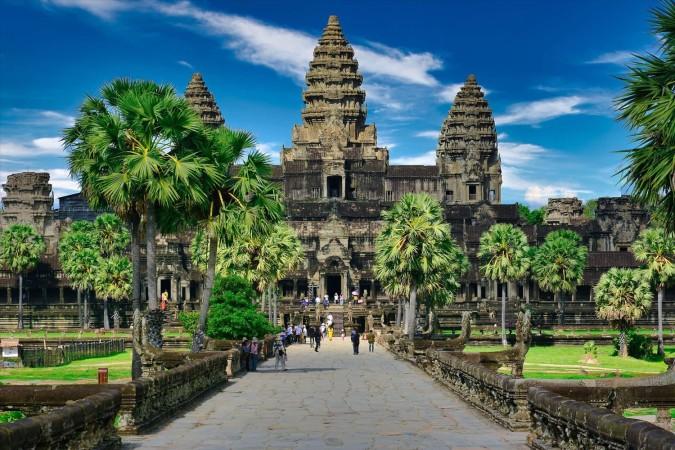
Angkor Wat - Icon of Cambodia's Ancient Heritage
"Angkor's original name was Yashodharapura (“Glory-bearing city”), and at its apogee it was the biggest city in the world, covering an area of a thousand square kilometers," remarks Rodrigo Quijada Plubins, a writer at The World History. This architectural marvel, dating back to the 12th century during the Khmer Empire's zenith, stands as the world's largest religious monument and a UNESCO World Heritage site. Its intricate bas-reliefs, depicting mythological scenes and historical events, unfold stories of a bygone era with each intricately carved stone.
Navigating Angkor Wat requires a blend of historical appreciation and practical insights. A sunrise over Angkor Wat, with its lotus-bud towers silhouetted against a vibrant sky, is a moment that etches itself into the soul of every traveler. Visitors are encouraged to explore beyond the central sanctuary, where the stone causeways and serene ponds mirror the temple's grandeur and spiritual significance. As the morning mist dissipates, revealing the temple's grandeur, visitors are encouraged to explore beyond the central sanctuary, where the stone causeways and serene ponds mirror the temple's grandeur and spiritual significance.
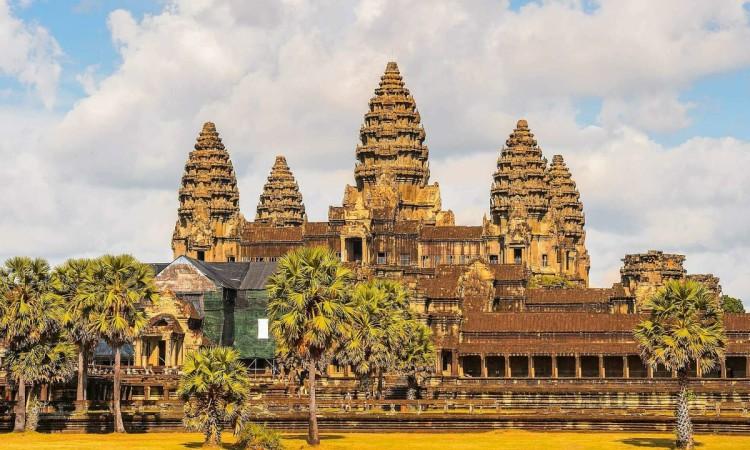
Angkor Wat - © VnExpress
Beyond Angkor Wat: Lesser-Known Ancient Sites
Each of these lesser-known ancient sites offers a unique window into Cambodia's rich cultural tapestry and architectural splendor beyond Angkor Wat. As visitors traverse their storied paths and contemplate the intricate carvings, they embark on a journey through time and spirituality, uncovering the hidden narratives that define Cambodia's ancient past.
1. Bayon Temple - Faces of Serenity Amidst Ancient Ruins
Hidden within the heart of Angkor Thom, the Bayon Temple emerges as a mystical labyrinth of smiling stone faces. Constructed in the late 12th century by King Jayavarman VII, this architectural marvel stands as a testament to Mahayana Buddhist ideals and Khmer artistry. "Bayon is not just a temple; it's a spiritual journey through the faces of Avalokiteshvara, the bodhisattva of compassion," shares Dr. Melody Rod-ari, Assistant Curator of Asian art at the Norton Simon Museum and Editor for the American Council for Southern Asian Art.
Bayon's allure lies not only in its intricate bas-reliefs but also in its architectural symmetry, with towers adorned by over 200 serene faces believed to depict the King himself or a form of the Buddha. Navigating its narrow corridors and steep stairways leads visitors deeper into its enigmatic history and cultural significance. "Every stone tells a story," Dr. Rod-ari remarks, pointing to carvings that narrate battles, daily life scenes, and celestial beings, offering a glimpse into Khmer society's complexities.
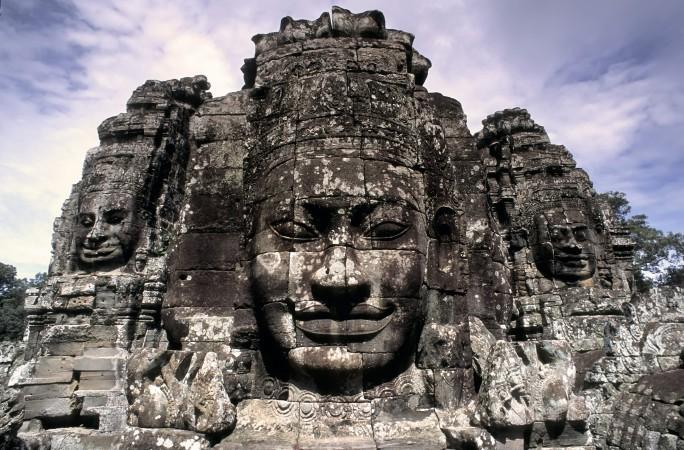
Bayon Temple - © gather
2. Ta Prohm - Nature's Embrace of Ancient Ruins
Venturing into the embrace of nature at Ta Prohm reveals a captivating fusion of human ingenuity and natural forces. Built in the late 12th century by King Jayavarman VII as a Mahayana Buddhist monastery and university, Ta Prohm is perhaps best known for its entwined roots and crumbling towers, immortalized in scenes from the movie "Tomb Raider." Here, nature and architecture dance in harmony preserving Cambodia's heritage in both ancient architecture and natural beauty.
Unlike many other Angkorian temples, Ta Prohm has been intentionally left in a partially collapsed state, allowing the roots of towering silk-cotton and strangler fig trees to intertwine with its weathered stone walls. This surreal symbiosis evokes a sense of timelessness and reverence for the passage of centuries. "It's a living monument where history meets nature," a local guide reflects, underscoring the site's spiritual and ecological significance.
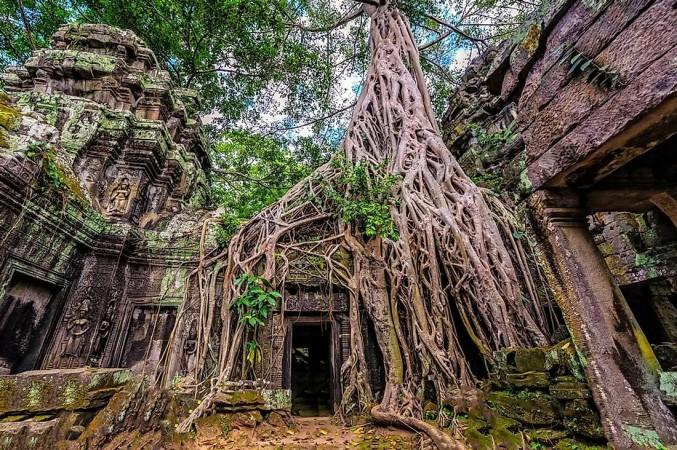
Ta Prohm - © Phuotvivu
3. Preah Khan - Serenity Amidst Forgotten Splendor
Nestled amidst dense jungle, Preah Khan stands as a testament to King Jayavarman VII's expansive vision and compassionate rule. Built in the late 12th century as a monastic complex and university, Preah Khan once housed over 1,000 teachers and served as a hub of learning and spiritual practice.
The temple's labyrinthine corridors and courtyards lead visitors through a maze of carved galleries, serene courtyards, and ornate sanctuaries dedicated to Buddhist and Hindu deities. Its grandeur is complemented by the surrounding jungle's embrace, offering a glimpse into the spiritual and practical aspects of daily life during the Khmer Empire's peak. It's a place where scholars once debated and monks found solace, which contributes in highlighting Preah Khan's role as both a center of learning and a place of spiritual retreat.
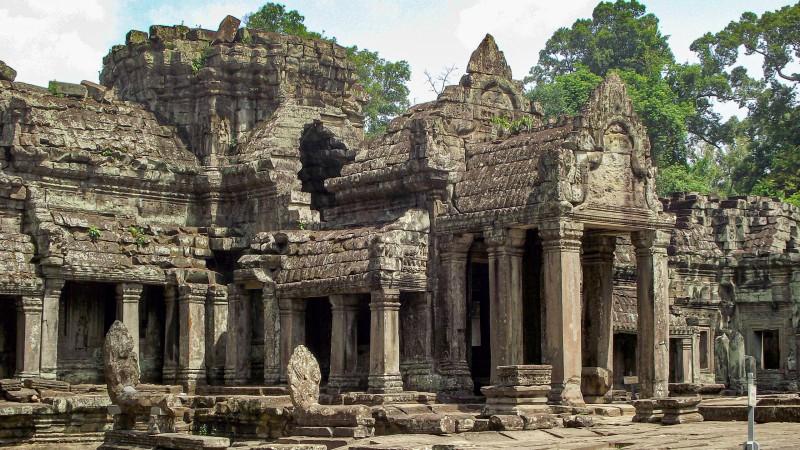
Preah Khan - © gather
Natural Beauty of Cambodia
Exploring these natural marvels beyond Angkor Wat not only unveils Cambodia's diverse landscapes but also fosters a deeper understanding of its ecological significance and cultural richness. Whether marveling at cascading waterfalls, cruising on Tonle Sap's expansive waters, or trekking through pristine rainforests, each experience invites travelers to connect with Cambodia's natural heritage and contribute to its sustainable future.
1. Tonle Sap Lake - Lifeblood of Cambodia's Ecosystem
Spanning across the heartland of Cambodia, Tonle Sap Lake is not just Southeast Asia's largest freshwater lake but also a thriving ecosystem crucial to the country's biodiversity and economy. During the monsoon season, the lake's waters swell, expanding its surface area nearly fivefold and giving rise to its nickname, "the beating heart of Cambodia."
The lake supports a rich diversity of flora and fauna, including over 300 species of freshwater fish and numerous bird species. Floating villages dot its shores, where communities live in stilt houses, relying on fishing and aquaculture for their livelihoods. Exploring Tonle Sap offers visitors a glimpse into traditional Khmer village life and the delicate balance between human existence and natural abundance.
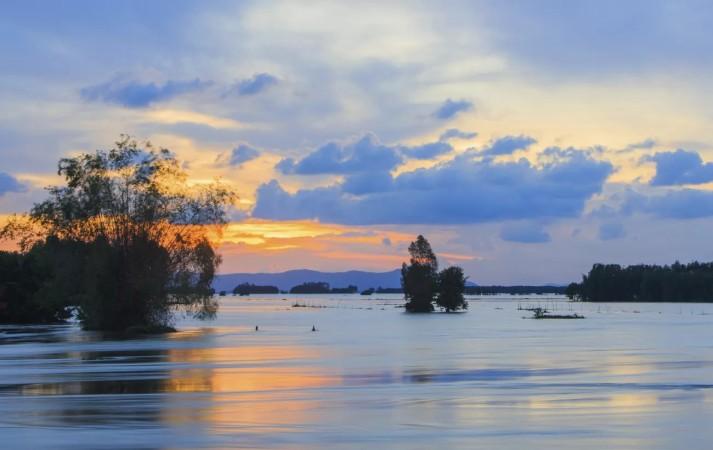
Tonle Sap Lake - © Adventure Life
2. Kulen Mountain National Park - Sacred Landscapes and Natural Wonders
Tucked away in Cambodia's northern province of Siem Reap, Kulen Mountain National Park beckons adventurers with its sacred sites, cascading waterfalls, and lush jungles teeming with wildlife. Revered as Cambodia's birthplace, Kulen Mountain holds historical and spiritual significance, with ancient temples and Hindu pilgrimage sites nestled amidst its rugged terrain. This place is where Cambodia's ancient kings sought spiritual solace and divine blessings.
The park's attractions include the towering Phnom Kulen waterfall, whose cool waters offer respite from the tropical heat, and the intricately carved River of a Thousand Lingas, believed to bless the waters that flow to the kingdom below. Hiking trails wind through dense forests inhabited by macaques and exotic bird species, offering nature enthusiasts a glimpse into Cambodia's untamed wilderness. Sustainable tourism initiatives ensure that Kulen Mountain's natural beauty and cultural heritage remain preserved for future generations to explore and cherish.
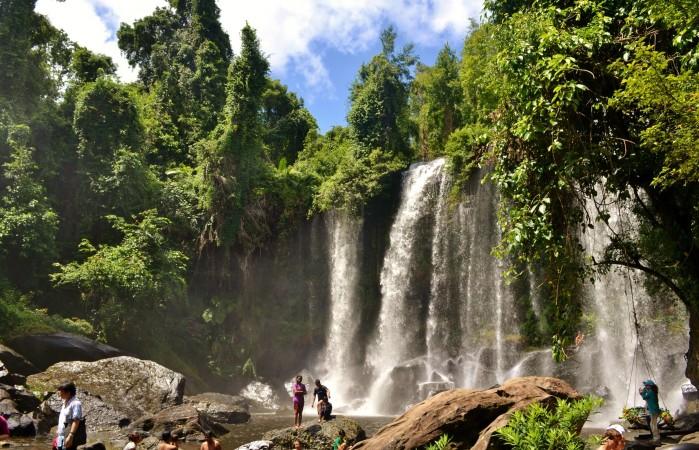
Kulen Mountain National Park - © gather
3. Cardamom Mountains - Biodiversity Hotspot and Eco-Tourism Haven
In southwestern Cambodia lies the rugged expanse of the Cardamom Mountains, one of Southeast Asia's largest remaining rainforests and a biodiversity hotspot. Home to rare wildlife such as clouded leopards, Asian elephants, and the elusive Siamese crocodile, this remote region offers intrepid travelers a glimpse into Cambodia's wild heart. "The rainforests of the Cardamom Mountains in southern Cambodia and Thailand are considered one of the most species-rich tropical rainforest ecosystems in Southeast Asia," remarks Eric Wikramanayake, a conservationist, PhD and Senior Specialist of Rewilding Programme, One Earth Community.
Eco-tourism initiatives here emphasize sustainable practices, from guided treks through dense forests to community-based homestays that immerse visitors in local culture. Conservation efforts aim to protect endangered species and promote responsible travel, ensuring that the Cardamom Mountains remain a sanctuary for both wildlife and those who seek to experience Cambodia's natural wonders authentically.
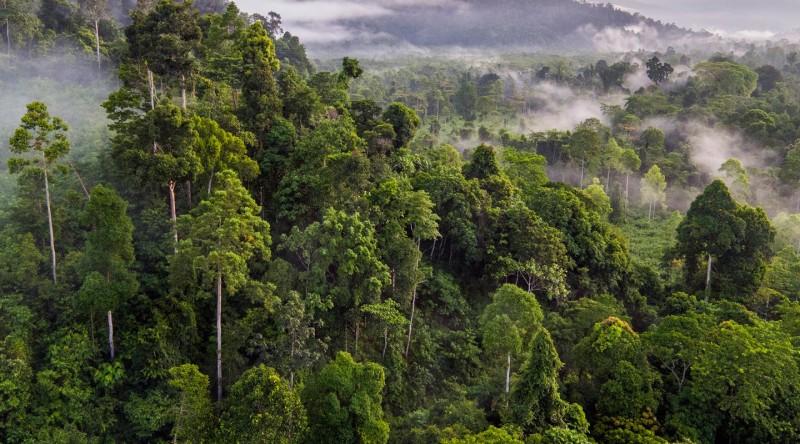
Cardamom Mountains - © Wildlife Alliance
Travel Tips and Practical Information
Best Time to Visit
Cambodia's climate is characterized by distinct wet and dry seasons. The best time to see Angkor Wat and other ancient structures is during the dry season, which lasts from November to April, when the weather is cooler and rainfall is lower. The months of December to February offer pleasant temperatures, making it ideal for exploring temples and outdoor activities. However, traveling during the shoulder seasons of November and March-April might give a balance of fewer visitors and more pleasant weather conditions.
Local Culture and Etiquette
Respect for Cambodia's rich cultural heritage is paramount. When visiting temples like Angkor Wat, it's important to dress modestly, covering shoulders and knees out of respect for religious customs. Removing shoes before entering temple grounds is customary to maintain cleanliness and show reverence. Engaging with locals respectfully and learning a few basic Khmer phrases can also enhance cultural interactions and foster meaningful connections during your travels.
Sustainable Travel
Embracing sustainable travel practices ensures that Cambodia's natural and cultural treasures are preserved for future generations. Considering Tweet Tours’ eco-friendly itineraries that prioritize environmental stewardship and support local communities. Carrying reusable water bottles and bags helps to reduce plastic waste. Participate in responsible wildlife encounters and support ethical representatives that contribute positively to local economies and conservation efforts.
Transportation
Getting around Cambodia is relatively straightforward, with options ranging from tuk-tuks and motorbike taxis to buses and private drivers. In Siem Reap, tuk-tuks are a popular and affordable mode of transport for exploring Angkor Archaeological Park. For longer journeys between cities, comfortable buses and domestic flights provide efficient travel options. Planning transportation in advance can help optimize your itinerary and enhance your overall travel experience.
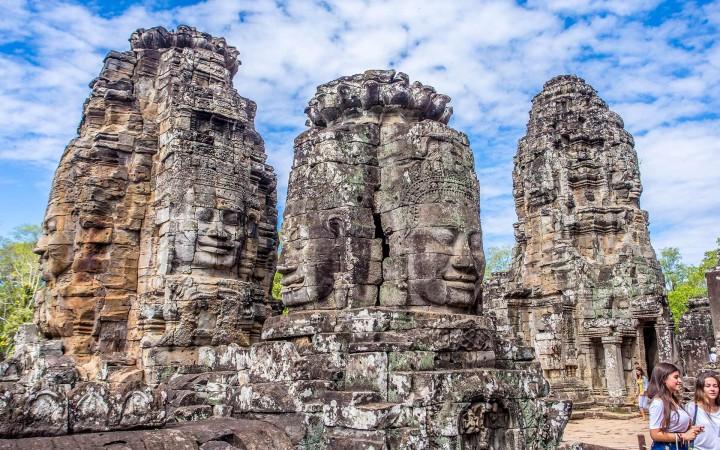
Bayon Temple - © gather
Conclusion
In the heart of Southeast Asia, Cambodia beckons adventurers with its tapestry of ancient wonders and natural beauty beyond Angkor Wat. From the mystical smiles of Bayon Temple to the tranquil waters of Tonle Sap Lake and the untamed forests of the Cardamom Mountains, each destination tells a story of resilience and cultural richness.
As you plan your journey through Cambodia, remember that it's more than just a destination; it's an immersive experience into history, spirituality, and natural splendor. By exploring lesser-known sites, respecting local customs, and embracing sustainable travel practices, you not only enrich your own travels but also contribute to the preservation of Cambodia's heritage for future generations.
Embark on a voyage that transcends time and space, where ancient ruins and vibrant ecosystems converge to create unforgettable memories. Whether you're captivated by temple carvings or enchanted by the call of exotic wildlife, Cambodia offers a journey of discovery and wonder that leaves an indelible mark on every traveler's soul.
Articles for you

Experience Aboard The RV Indochine II - A Mekong Cruise With Tweet World Travel
The RV Indochine II is a luxury river cruise ship, offering an unforgettable journey through many attractions along the Mekong River. Built in 2017, this upscale vessel combines colonial elegance with modern conveniences to create a comfortable yet stylish environment for its crew and passengers. The ship’s intimate size makes it ideal for those seeking a more personal cruising experience while exploring Vietnam and Cambodia rich culture, scenery, and heritage. Whether you're gazing at the landscape from your private balcony or enjoying authentic local cuisine, RV Indochine II promises an exotic adventure like no other.

Witness Stilt Fishing In Sri Lanka: An Eco-Tourism Experience
Sri Lanka, renowned for its stunning beaches and rich cultural heritage, harbors a unique tradition that has captivated travelers for centuries: stilt fishing. This ancient practice, passed down through generations of coastal communities, blends artistry with necessity, offering a glimpse into a way of life intimately connected to the island's coastal rhythms. Stilt fishing in Sri Lanka isn't merely a means to catch fish; it's a cultural emblem, embodying the resilience and ingenuity of Sri Lanka's fishing communities.

Make Your Trip Stress-Free With The Tweet Trip App
Embark on your next adventure with confidence by downloading the Tweet Trip App, available for both iOS and Android. This essential travel companion allows you to view your detailed itinerary, stay connected with your tour guide and fellow travelers, receive real-time updates, and provide feedback effortlessly. With features like in-app messaging, emergency assistance, and location sharing, the Tweet Trip App ensures you travel smarter, stay connected, and enjoy a seamless, worry-free journey. Get started today and make the most of your travel experience with Tweet World Travel.

Pedal Through Paradise: Unveiling Cambodia's Hidden Gems on Two Wheels
The gentle whir of bicycle wheels mingles with the distant chants of monks as you glide past emerald rice paddies stretching to the horizon. This is Cambodia - a sensory explosion waiting to be experienced on two wheels. At Tweet Tours, we believe there's no better way to immerse yourself in the Kingdom of Wonder than by bicycle.
Cambodia isn't just a destination; it's a living, breathing tapestry of ancient wonders, natural beauty, and vibrant culture. Our carefully crafted cycling tours take you beyond the typical tourist haunts, offering a unique perspective on this captivating country. Ready to clip in and discover the magic of Cambodia? Let's ride!

Trekking in the Himalayas: A Journey Through Nepal's Majestic Peaks
The Himalayas rise from the earth like colossal guardians, their snow-capped peaks piercing the sky in a display of nature's raw power and beauty. Nepal, nestled at the heart of this mountain range, serves as the gateway to some of the most breathtaking trekking experiences on the planet. Here, the air is crisp and thin, filled with the promise of adventure and the whispers of ancient tales.
With Tweet Tours, as you set foot on these hallowed trails, you're not just a traveler - you're a modern-day explorer, following in the footsteps of legendary mountaineers and age-old traders. Each step takes you further into a world where nature reigns supreme and human resilience is tested against the backdrop of some of the world's highest peaks.
From the moment your boots touch the ground in Kathmandu, you'll feel the pull of the mountains. The bustling streets of the capital, with their sensory overload of sights, sounds, and smells, soon give way to serene mountain paths where the only soundtrack is the crunch of gravel underfoot and the distant tinkling of yak bells.

Exploring Mui Ne's Wonders: Unique Attractions & Local Dishes
Nestled along the southeastern coast of Vietnam, Mui Ne emerges as a captivating gem, blending natural wonders with cultural richness. Renowned for its stunning landscapes and unique attractions, Mui Ne beckons travelers seeking both relaxation and adventure in equal measure. Mui Ne's renowned beach dunes, bustling fishing towns, and excellent local food await exploration at every turn.
The allure of Mui Ne lies not only in its pristine beaches and crystal-clear waters but also in its diverse range of activities catering to every traveler's whims. Whether you're drawn to thrilling water sports like kitesurfing and windsurfing on its dynamic shores or seeking tranquility amidst the picturesque Fairy Stream, Mui Ne promises an unforgettable journey filled with discovery.
